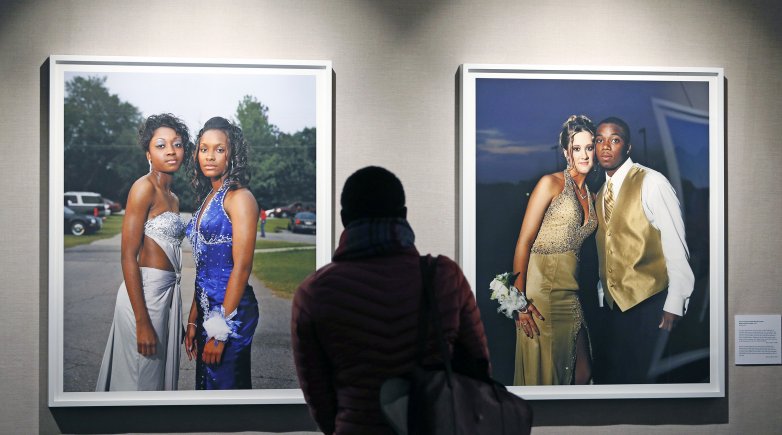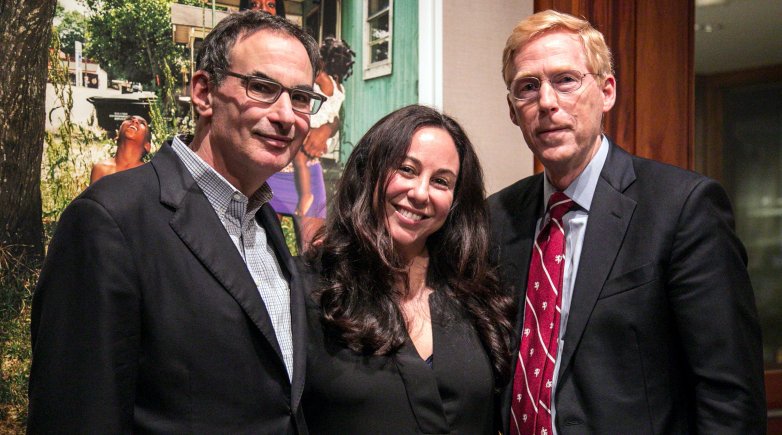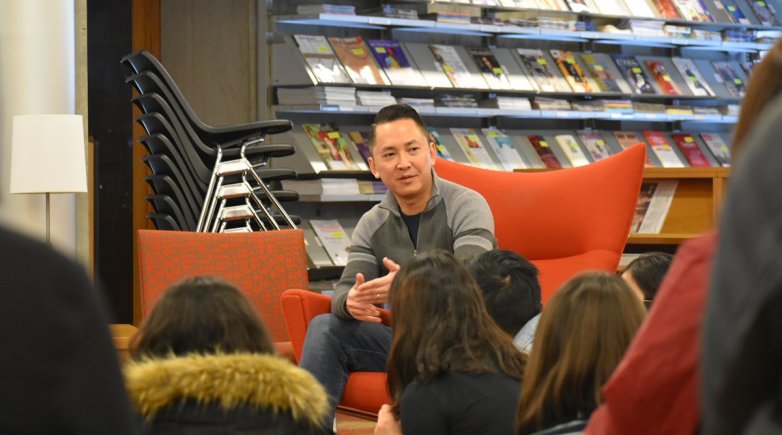Photography takes students beyond black and white
“Southern Rites” exhibition at the Lamont Gallery sparks dialogue about racism, inclusion and equity.
A visitor views Gillian Laub's photographs on display at the Lamont Gallery.
Pictures of teens decked out for prom in sparkling gowns and suits studded with baby’s breath boutonnières don’t usually elicit outrage. But Gillian Laub’s photographs of racially divided dances in rural Georgia have that effect. “I’m overwhelmed by sadness and anger,” says prep Amelia Scott, who viewed Laub’s eye-opening portraits at the Lamont Gallery this fall with her English class. “I’m shocked at how far we’ve come, but how little we’ve changed,” she says. “The idea of segregated proms just completely blows my mind.”
Laub’s images were first published in The New York Times Magazine in 2009 as a photo essay, “A Prom Divided.” The article brought national attention to one town’s long-standing but little-known tradition, and forced an end to its practice of segregation. For the next decade, Laub continued to document the lives of the young people she met in Montgomery County and their community’s struggle with integration, ultimately producing this traveling exhibition and an HBO documentary about a racially charged homicide involving one of the students she had photographed years earlier.
Helping students visualize and confront the societal ills Laub reveals in shocking technicolor — including institutionalized racism, wealth inequities, police violence and gender conformity — is part of what inspired Marina and Andrew Lewin ’77; P’07, P’10 to underwrite the “Southern Rites” premiere exhibition at the Academy. “Race is the national trauma and a big issue right now,” Andrew Lewin says. “And I believe that we need to discuss it and people need to acknowledge it.”
Hosting this show on campus is also a very visible way for the Academy to underscore its commitment to equity and inclusion and foster awareness of assumptions, empathy and compassion, both in the classroom and beyond. “I think it’s particularly important for students at this school,” Lewin says. “I’m hoping that what we’re doing by bringing this work and these voices here, is that we’re going to get the students to think.”
Classes prepare to visit the exhibition
For months over the summer, English instructors — including Christine Knapp, Michelle Dionne, Courtney Marshall, Wei-Ling Woo and Erica Plouffe Lazure — gathered to develop coursework to accompany the “Southern Rites” exhibit. They wrestled with ideas about how to effectively teach students to talk about the thorny topics Laub lays bare. How can we help students get beyond the black and white, they wondered? “I think that what happens is that at first students are shocked that segregated proms have happened in their lifetime,” Knapp says. “For some of them, that’s a huge awakening, a kind of lightning strike. But I hope they go past that.”
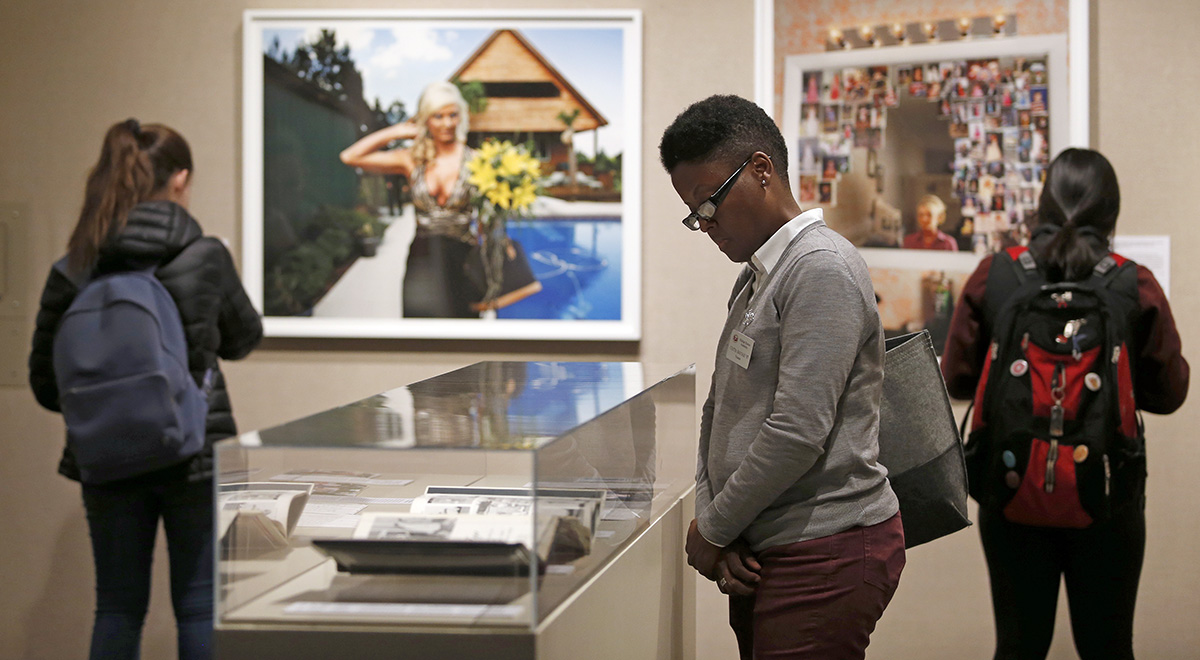
Before her English 310 students ever stepped foot inside the gallery, Knapp devoted a substantial amount of time preparing them for what they were going to see. She wanted them to not only view the art and analyze it, but to really be equipped to delve into its deeper meanings. To start, she asked students to consider a New Yorker cover illustration that illuminated the controversy and divide over gun control. “I chose that because I think it’s a loaded issue, but one that is also close to the hearts of a lot of teenagers and young people in schools who live in fear of gun violence,” Knapp says. A sobering fact: There were hate crimes investigated in the United States, either racially or ethnically inspired (two involving guns), on the day preceding, the day after, and two days following the “Southern Rites” opening at the Lamont Gallery.
Next she asked the students to find an image from their own lives that caused a strong reaction. They discussed how the image worked to elicit a response using the language of photography: foreground, frame, perspective, contrast. “I wanted them to be prepared to look at the photograph as a composition — as a piece of art,” Knapp says. “I thought that might make them more comfortable talking about the larger issues. It’s very easy to separate, this is good, this is bad, or this is black and this is white. I didn’t want them to do that. I think asking them to be able to interpret the complexities of the photograph will also help them interpret the complexities of the issues.”
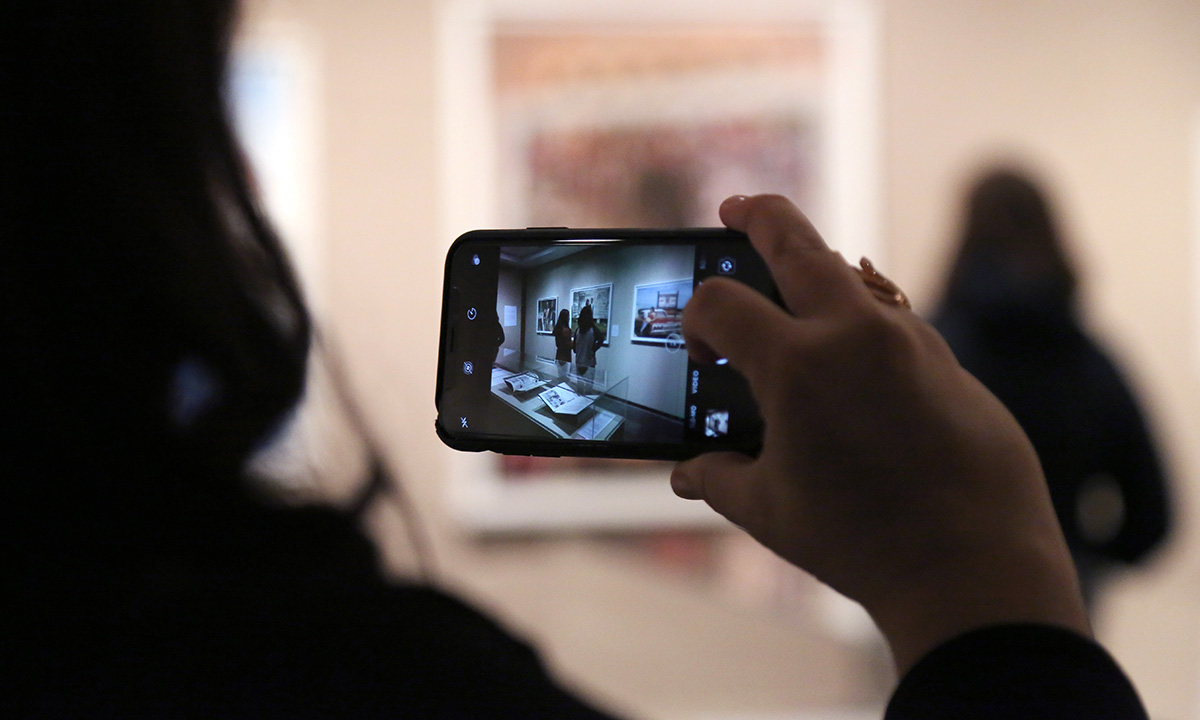
The class was also assigned a reflection on Gordon Parks’ “The Restraints: Open and Hidden,” a pictorial essay that ran in Life Magazine in September 1956. Part of Life’s “Background of Segregation” series, the article chronicled the day-to-day effects of segregation as seen through the life of one Alabama family. For homework, students wrote about a time they felt like a space was closed to them. They considered who controls those spaces, who decides who gets access and who does not. The assignment made the impersonal, personal.
An English class reflects
Finally, in late October, Knapp and her English class visited the Lamont Gallery and examined the collection. Their task: observe, interpret, react and connect. “Study one picture and record what you see,” Knapp said as students fanned out across the gallery. “Write bullet points, fragments, concrete details. … Record shapes that invite your gaze to move through the photograph. … Notice the relationship between the subject and the background.”
At the back of the gallery, seated at a Harkness table the 12 students began to parse and share their thoughts. They moved from observation and inference to interpretation and reaction. “I was disturbed to see that this type of discrimination is still here,” said one student. “I thought discrimination would be gone, but there is still discrimination, and what is the way to decrease it?”
Like the subjects in the photographs, the issues are complex. The reactions are emotional. The students are careful, engaged, simultaneously investigating their own notions and prejudices while discussing those of others. When students posed the question, “Why didn’t the black students protest?” they realized that the question itself passed judgment on the students of color in the community and assigned blame to them.
After reflection, they refined the question and asked, “What obstacles prevented the black students from speaking out or protesting?” The students contemplated how, in their position as privileged individuals, it could be hard to understand why someone might not stand up for themselves. This led to a discussion of the systemic racism that allowed the segregated prom in this town to be a norm. “When the tradition is part of the majority it just gets institutionalized,” said one student. “If you’re part of the minority, it’s really hard to speak up against that.”
The class block ends, but the conversation continues in the dorms, in advisee groups and, of course, around the Harkness table in the coming months. Knapp’s class will conclude the fall term by reading The Taming of the Shrew, where themes from the play of traditional courtship norms and expectations, clothing and appearance can now be understood through a wider lens. “Our major writing assignment for the term will come out of the exhibition,” Knapp adds. “Hopefully, they’ll have something powerful, a weighty moment from their own life that they can really look back at and examine.”
